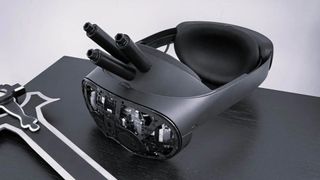Oculus co-founder creates a 'thought-provoking' VR headset that will literally kill you if you die in a game
When "if you die in the game, you die in real life" is taken to its extreme.

Oculus co-founder Palmer Luckey has come up with an innovative and incredibly dangerous crossing of virtual reality and the real world: A VR headset that will literally kill you if you die in a game.
The headset isn't a real product; it's something more like a thought experiment made into cosplay.
Luckey introduced the idea of the headset in a blog post that describes the "SAO Incident," a fictional event in the Sword Art Online series that saw 10,000 players trapped in a VRMMORPG, 4,000 of whom would ultimately die as a result of their in-game deaths. The SAO Incident—in the fiction—began on November 6, 2022, and to mark that anniversary Luckey unveiled his own 'play-or-die' creation on his blog.
"The idea of tying your real life to your virtual avatar has always fascinated me—you instantly raise the stakes to the maximum level and force people to fundamentally rethink how they interact with the virtual world and the players inside it," Luckey wrote. "Pumped up graphics might make a game look more real, but only the threat of serious consequences can make a game feel real to you and every other person in the game.
"This is an area of videogame mechanics that has never been explored, despite the long history of real-world sports revolving around similar stakes."
The headsets in Sword Art Online, called NerveGear, used high-intensity bursts of microwaves to kill their wearers; Luckey's device takes a more kinetic approach to melting brains. It has three explosive charges embedded it, positioned directly atop the user's forehead and connected to a "narrow-band photosensor" designed to detect a particular shade of red. When an integrated game-over screen appears, the color will flash and the charges will fire, "instantly destroying the brain of the user."
The whole thing is troll-shaded theatrics, of course, and Luckey couldn't help but add a supervillain flourish when describing his future ideas for the device, saying he has "plans for an anti-tamper mechanism that, like the NerveGear, will make it impossible to remove or destroy the headset."
The biggest gaming news, reviews and hardware deals
Keep up to date with the most important stories and the best deals, as picked by the PC Gamer team.
Has Palmer Luckey actually developed a real-life Call Up device? At the very least, it's fair to assume he has the capability of putting a bomb into an Oculus Quest: After leaving Facebook, which acquired Oculus for $2 billion in 2014, Luckey founded a defense tech company called Anduril Industries, which develops autonomous defense systems for the US military—and thus presumably makes it easier for him to get his hands on things that explode. He also said in the post that the triggering device "should really be tied to a high-intelligence agent that can readily determine if conditions for termination are actually correct," which sounds like a pretty explicit connection to the work being done at Anduril—not that I'm suggesting he's developing an AI-powered assassination device or anything like that. Luckey said in his blog post that he normally uses the embedded explosives "for a different project."
Regardless of what's actually packed in there, Luckey clarified that he is not actually using the thing, although he predicted that someday, someone might.
"There are a huge variety of failures that could occur and kill the user at the wrong time," he wrote. "This is why I have not worked up the balls to actually use it myself, and also why I am convinced that, like in SAO, the final triggering should really be tied to a high-intelligence agent that can readily determine if conditions for termination are actually correct.
"At this point, it is just a piece of office art, a thought-provoking reminder of unexplored avenues in game design. It is also, as far as I know, the first non-fiction example of a VR device that can actually kill the user. It won’t be the last."
Andy has been gaming on PCs from the very beginning, starting as a youngster with text adventures and primitive action games on a cassette-based TRS80. From there he graduated to the glory days of Sierra Online adventures and Microprose sims, ran a local BBS, learned how to build PCs, and developed a longstanding love of RPGs, immersive sims, and shooters. He began writing videogame news in 2007 for The Escapist and somehow managed to avoid getting fired until 2014, when he joined the storied ranks of PC Gamer. He covers all aspects of the industry, from new game announcements and patch notes to legal disputes, Twitch beefs, esports, and Henry Cavill. Lots of Henry Cavill.
Most Popular





